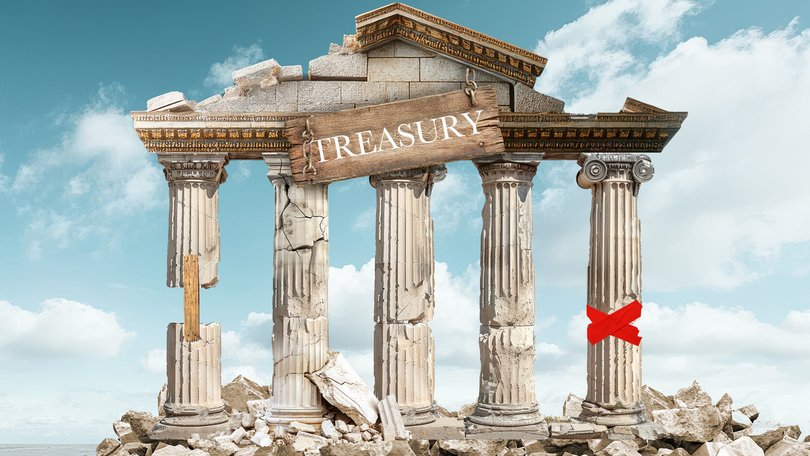Australian finance: The Big 5 tax reforms economists favour

Australia’s leading economic thinkers have welcomed Treasurer Jim Chalmers’ decision to start the clock on long-overdue economic reform, agreeing the nation’s long-term spending trajectory is unsustainable, the tax system overly complex, and innovation efforts falling short.
Despite historically high tax revenues, low unemployment, and robust terms of trade, the federal Budget faces a decade of deficits of $30 to $40 billion a year, with gross debt set to exceed $1 trillion by 2025–26.
At the same time, the structural gap between spending and revenue is deepening, as an ageing population simultaneously drives up government expenditure, particularly in health, aged care, and pensions, while shrinking the income tax base.
Sign up to The Nightly's newsletters.
Get the first look at the digital newspaper, curated daily stories and breaking headlines delivered to your inbox.
By continuing you agree to our Terms and Privacy Policy.Dr Chalmers has declared this is unsustainable from the point of view of “intergenerational justice”, given it will be the nation’s youth who will have to increasingly carry the tax burden while house affordability soars further out of reach.
To solve that issue, the Treasurer has put tax reform back on the table, but has indicated he is not a fan of changing the GST, nor is he likely to be moved on bringing in an inheritance tax or changing the tax exempt status of the family home.
So where does that leave the country in terms of transformative tax policies? The Nightly spoke to six leading economists: Robert Breunig of the ANU Crawford School’s Tax and Transfer Policy Institute, Brendan Coates of the Grattan Institute, Adam Creighton of the Institute of Public Affairs, Stephen Smith of Deloitte Access Economics, Matt Nolan of think tank e61, and Cassandra Winzar, Chief Economist at CEDA, to find out which reforms deserve serious consideration.
Plenty of ideas were discussed, but only the top five made the list. Other proposals, such as lowering the corporate tax rate or finding new ways to tax resource companies, were considered less urgent than the “big five”.
1. Shift happens: Move from stamp duty to a land tax
There was a clear consensus that the way houses are taxed is not working, with every economist agreeing that the current model of taxing housing via stamp duty was not only inefficient but responsible for perverse outcomes that encouraged older Australians to stay in homes longer than necessary, exacerbating the affordability crisis.
“It’s a no-brainer,” said Mr Smith. “From a productivity and fairness point of view, replacing stamp duty with a broad-based land tax is about as close as you get to a universally supported reform — yet governments keep dodging it.”
Mr Creighton lamented the scrapping of New South Wales’ gradual transition scheme. “It’s very sad,” he said. “We talk endlessly about housing affordability, but the biggest problem of all is stamp duty — you throw $45,000 against the wall every time you move. It’s a tax that traps people in place.”
Mr Breunig said a properly designed land tax would encourage more efficient use of the housing stock and free up supply. “People right-size more easily — older people move to smaller places, young families get access to bigger ones. That makes a difference to prices,” he said. “Everyone knows it’s a good idea. It’s just politically hard. But if you staged it in over 20 years with strong transition arrangements, you could absolutely do it.”
2. G-Force: Broaden the GST
While politically contentious, broadening or increasing the GST was widely supported by the economists, who argued it was one of the fairest and most efficient ways to raise revenue. Mr Nolan said the GST could promote intergenerational equity by acting as “a one-off tax on wealth,” since older Australians were more likely to consume and had benefited from demographic and housing trends.
Although commonly viewed as regressive, Mr Nolan said OECD research showed GST systems “tend to be relatively neutral” over a person’s lifetime, and that exemptions such as private school fees actually made the system more regressive.
Mr Breunig said a higher GST could be justified “if you compensate low-income households” through transfers or tax cuts.
Mr Smith called it “the most efficient large-scale tax,” though noted it remained “radioactive” due to political resistance. He suggested a good option would be to keep the 10 per cent rate that went to the states, while an additional 5 per cent could be collected as Federal revenue.
Mr Creighton opposed lifting the rate above 10 per cent, saying it had “psychological value” at that level. “Once it goes up, once, it’ll go up other times, which is exactly what happened in Europe.” He instead argued that all current exemptions should be scrapped to widen the base.
3. Super tithe me: Change the way investments are taxed
Reforming how Australia taxes wealth — not just income — must be central to any serious effort to improve fairness and economic efficiency, the economists universally said.
With an ageing population and growing intergenerational tensions, many see a need to better target concessions that disproportionately benefit older, wealthier Australians.
One area of focus is superannuation, where individuals over 60 can currently earn investment income tax-free in retirement. Ms Winzar warned that “plenty of people are really using superannuation to build pretty big investment balances,” while Mr Nolan called it “pretty much a tax shelter.”
Mr Creighton said what had been a sensible system to provide a comfortable retirement had become skewed: “You’ve got very wealthy people who are not really paying income tax … and then you’ve got families in their 30s and 40s who are paying 47 cent marginal rates on their work. I don’t see how anyone can say that is reasonable.”
Capital gains tax concessions were also criticised for distorting investment decisions. Mr Breunig said the CGT discount should be scrapped or substantially reduced, while Mr Smith called for the 50 per cent discount to be cut to 25 or 33 per cent. Though primarily a budget repair measure, he noted it would help reduce tax expenditures that favour wealthier individuals.
4. Means to an end: Tighten up means testing
Tightening the means testing of government benefits was a rare point of near-unanimous agreement among the economists consulted. A key focus was the exemption of the family home from the age pension assets test — a policy increasingly seen as outdated and inequitable.
Mr Coates questioned whether it was fair “for someone with a $3 million home to receive the pension,” and proposed including properties above a $750,000 threshold. Mr Breunig endorsed the idea with a slightly higher cut-off at $1 million, while Mr Smith also backed the reform, calling it a sensible way to target assistance more effectively.
Ms Winzar argued it was part of a broader problem in how the system treats wealth and capital. “If we’re going to reduce reliance on things like income tax, we also need to look at how we’re taxing wealth,” she said, including how the family home is treated under the pension test.
All agreed that better incorporating housing wealth into the social safety net would improve both its fairness and sustainability.
5. Rate expectations: Lower income and corporate tax rates
The final pillar in the reform agenda is reducing headline tax rates — particularly those that discourage work, investment, and global competitiveness. Economists were broadly supportive of lowering marginal personal and company tax rates, provided the revenue could be recovered through a more efficient tax mix.
Mr Creighton pointed to the international disparity, noting that “Communist China’s top marginal rate is lower than ours,” and called it “an outrage” that Australians face a 47 per cent marginal rate at relatively modest incomes.
Mr Breunig also backed reducing marginal income tax rates, arguing that a simpler and fairer system would improve labour market participation and reduce distortions — particularly if paired with reforms to capital taxes and retirement savings concessions.
Company taxes should also be reduced to 25 per cent from 30 per cent, according to Deloitte’s Stephen Smith. Ms Winzar identified it as a key productivity lever which would “make us more competitive globally,” encouraging capital inflow and higher-value business investment — particularly important as Australia tries to foster a more innovative, high-skill economy.
Plenty of food for thought for the Treasurer.

